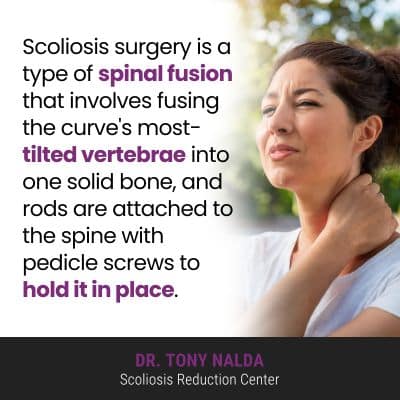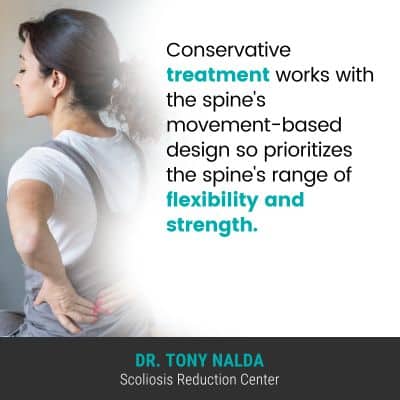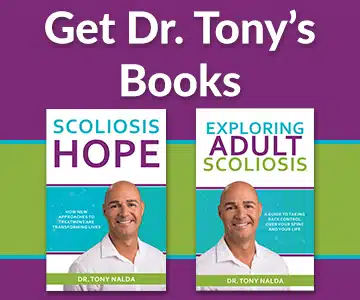Scoliosis surgery involves spinal fusion, and while there are different types, the approach and goal is the same: to stop scoliosis from getting worse. Each patient will respond to scoliosis surgery in their own way, and while some will maintain enough flexibility above and below the fused portion, others can experiences a noticeable loss in spinal flexibility and range of motion.
There are different ways to treat scoliosis, and the way scoliosis is addressed with treatment will shape the spine’s long-term health, including its strength and function. Scoliosis surgery is associated with a loss in spinal flexibility and range of motion.
Many patients are disappointed when their spines are less flexible after spinal fusion; this is because fusing the spine is contrary to its natural movement-based design.
The Spine’s Natural Curves
The spine is naturally curved at each of its main sections, and these curves make the spine stronger, more flexible, and better able to absorb and distribute mechanical stress.
The spinal sections consist of the cervical spine (neck), thoracic spine (middle/upper back), and the lumbar spine (lower back).
Each spinal section is dependent on the health of the others, and each section has unique roles to play in how the spine functions.
The cervical spine has to support the weight of the neck, the head, and facilitate the neck’s range of motion to move the head, and the thoracic spine is the largest spinal section, is attached to the rib cage and protects important organs; the lumbar spine has to support the weight of the spinal sections above, the entire trunk, and feels the effects of bending, lifting, and twisting motions.
If the spine’s natural and healthy curves are in place, its vertebrae are aligned in a straight and neutral position, preserving the spine’s biomechanics, but if the spine loses one or more of its healthy curves, they are replaced by unhealthy curves, and this disrupts the spine’s biomechanics.
Scoliosis causes the development of an unnatural sideways-bending and rotating spinal curve, and the condition is progressive, and progression is triggered by growth.
Scoliosis affects all ages but is most often diagnosed in children, and the most prevalent type overall is adolescent idiopathic scoliosis, diagnosed between the ages of 10 and 18.
What is Scoliosis Surgery?

Scoliosis surgery is a type of spinal fusion that involves fusing the curve’s most-tilted vertebrae into one solid bone, and rods are attached to the spine with pedicle screws to hold it in place.
The vertebrae being fused together have the spinal disc in between removed, and these discs are key to spinal health and function in a number of ways; they act as the spine’s shock absorbers, provide structural support (adjacent vertebrae attach to the disc in between), cushioning between adjacent vertebrae to prevent friction during movement, and combine forces to facilitate spinal flexibility.
The very design of the spine is based on movement, so fusing any number of vertebrae, and the removal of spinal discs, is contrary to that natural movement-based design.
Spinal fusion surgery is a costly, invasive, and risky procedure, and some patients have an intense recovery process.
The more vertebrae fused, the more invasive the surgery is, and the more likely it is to cause a noticeable loss in spinal flexibility and range of motion, and in addition, the location of the fusion is also important.
While some patients maintain enough spinal flexibility above and below the fused portion, others can experience a noticeably-rigid spine that impacts quality of life.
Spine surgery is invasive and always comes with the risk of infection and nerve damage, and fusion also comes with the risks of hardware failure and/or adverse reactions to hardware used.
So while most patients can bend their back after scoliosis surgery, many experience a noticeable loss in how far they can bend their back, and this reduced range of motion and increased spinal rigidity can involve activity restrictions that impact quality of life.
Spinal Fusion Recovery
The scoliosis surgery recovery process will be case specific, just as how each patient responds to spinal fusion surgery will be unique, but barring any complications during the procedure itself, the days immediately following the surgery are spent in the hospital being monitored for signs of infection, incision site care, and recovery.
Many patients are released from the hospital within nine days after being cleared by the spinal surgeon to continue recovery from home, during which time, driving, lifting, twisting, and bending motions are restricted.
Patients are weened off pain medication, typically, within two weeks, and once activity restrictions are lifted, patients can limit car rides and start slowly returning to daily activities.
So as spinal fusion surgery is invasive and risky, for those wanting to try a less invasive treatment option, there are the proven results of conservative nonsurgical scoliosis treatment to consider.
Can You Bend Your Back After Conservative Scoliosis Treatment?

Conservative treatment works with the spine’s movement-based design so prioritizes the spine’s flexibility and strength.
Conservative treatment is integrative, so patients of the Scoliosis Reduction Center® benefit from what condition-specific chiropractic care, physical therapy, corrective bracing, and rehabilitation have to offer, and they can impact conditions on all levels.
Reducing the Curve without Hardware
Instead of using surgery to hold the spine in a straight alignment through artificial means, conservative treatment is working towards actually correcting the scoliosis on a structural level, and this is worked towards through chiropractic care and a curvature reduction.
Instead of removing spinal discs between the most-tilted vertebrae and fusing them together to eliminate movement (progression), a number of chiropractic techniques and manual adjustments are applied to adjust the position of the vertebrae so they are more in alignment with the rest of the spine.
Physical Therapy and Spinal Support
As a curvature reduction is achieved, I shift the treatment focus to increasing core strength so the spine’s surrounding muscles can optimally support and stabilize the reduction and the spine’s straighter position.
Physical therapy can also help improve posture and address any related muscular imbalance; scoliosis is associated with the development of a muscular imbalance as the spine’s surrounding muscles are pulled in different directions in an attempt to stabilize it.
Building up strength in the spine’s surrounding muscles means the spine’s straighter position is supported, and scoliosis-specific exercises also help by activating specific areas of the brain for improved brain-body communication.
Although vertebral body tethering is a less-invasive form of spinal fusion that doesn’t involve cutting through muscle, spinal surgeries tend to involve cutting through muscle tissue to access the spine, which lengthens the healing process, and there is no recovery process or recovery time needed from conservative treatment because it’s a noninvasive approach that works with the spine’s natural design and function.
ScoliBrace
Corrective bracing is particularly effective on growing spines so is a common facet of treatment for childhood scoliosis, and this helps by pushing the spine into a corrective position and complements other forms of corrective treatment.
Rehabilitation for Sustainable Results
Rehabilitation is the ongoing part of treatment that’s necessary to sustain treatment results for the long-term; as a progressive spinal condition, treatment is about how best to manage a lifelong condition, and this can involve continued chiropractic care and the prescription of scoliosis-specific exercises to further heal and stabilize the spine from home.
Conclusion
While some patients undergo spinal fusion surgery and don’t notice being able to bend their backs less afterwards, others notice a loss in spinal flexibility and range of motion that affects quality of life.
In addition, increased pain at the fusion site and a spine that’s weaker and more vulnerable to injury are risks of spinal fusion surgery so should be considered carefully.
Living with a fused spine can involve activity restrictions that involve contact sports, full contact sports, and activities that involve repeated jarring impact like horseback riding, and the knowledge that a person’s spine is weaker can have a psychological effect.
Conservative treatment works to preserve as much of the spine’s natural strength and function as possible, so doesn’t involve a patient’s recovery and doesn’t permanently alter the spine’s health and function.
A fused spine is fused for life; hardware attached is permanent, and if the fusion is unsuccessful and/or hardware breaks over time, the only recourse is more surgery, and scoliosis patients face increasing potential risks with each subsequent procedure.
For older patients, back surgery is more risky and invasive, and any surgical procedure comes with its share of risks and potential complications.
Results of any type of scoliosis treatment will vary depending on a number of patient/condition variables, but when scoliosis is diagnosed early and treated proactively with conservative treatment, patients can lead fulfilling lives with spines that are strong and flexible.




